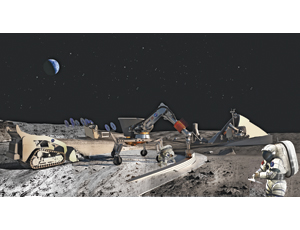
NASA is aiming to support surface construction on the moon within ten years.
Engineers with the U.S. National Aeronautics and Space Administration are on track to support surface construction on the moon within a decade, says Robert P. Mueller, senior technologist in the advanced projects development in the surface systems office for engineering and technology at NASA’s Kennedy Space Center.
 |
“Within the next two to three years we will build a dome in the lab; within five years we will be ready for a field test, and within 10 years we will be able to put something into space,” says Mueller. “It all depends on level of support,” he adds. “We’re hoping the commercial side develops as well on Earth, and that we can leverage that, [but] eventually we will have civil engineering in space.
NASA’s plan envisions robotic construction of surface facilities using indigenous materials and solar powered lasers for 3D printing. Mueller’s team is developing the equipment, tools and techniques to perform surface construction on either the moon or Mars to support gradually lengthening visits by humans.
Mueller says there are three main challenges to overcome. One is to develop the 3d additive printing machine and to be able to control the tool path and the positioning of the tool head. “That is getting close,” he says. Another is to develop the process to fuse by laser sintering the abundant regolith, or soil and rock that litters the lunar surface, into useful structural configurations. The use of indigenous materials helps overcome the third challenge, which is the very limited payload capacity of ships traveling from the earth to the jobsite.
“On earth you use water, Portland cement and aggregate to make water-based concrete, but in space we need to create concrete materials that don’t have any binders at all. Then we can start making civil engineering structures in space.”
The mechanics and controls for the printers are being developed in conjunction with Behrokh Koshnevis, a researcher at the University of Southern California who has been creating equipment and techniques he calls Contour Crafting to print buildings with low-slump, fast cure water-based concrete. The Lunar printers will work in the same way, except the print heads will be lasers directing beams to fuse the regolith into structures.
“The hardware is very feasible,” he adds. “This 3D additive construction has been done using normal fast curing concrete on Earth.” Questions remain about the laser sintering, though. “The low gravity is not so important, the vacuum will make a difference, but it’s mainly a temperature issue. Lunar soil sinters at about 800 C. I think we can prove that we can do it on Earth. And as long as we have some gravity on a planetary surface we should be able to do it there.”
Mueller says NASA’s construction plan aims to overcoming several issues. One big problem is caused by the rocket exhaust of spacecraft landings. Large rockets would be needed to ferry the equipment and supplied needed to build habitation. But the larger the rocket, the heavier the blast required to slow it for touchdown and the larger the crater it would make in the surface, creating a risk of spaceships landing and toppling over.
NASA intends to address that by landing robotic construction equipment and directing it telemetrically from a spacecraft orbiting above. The first task would be to build a landing pad, then roads and berms to deflect rocket blast up from the surface, and then shelters for protecting equipment, and eventually, people.
Field trials of NASA’s system for 3D laser printing will start in five years, probably using volcanic soil in Hawaii as a stand-in for lunar soil, says Mueller. “Volcanic ash is very similar to the regolith in a planetary environment,” he says.“
Mueller says the site for a first lunar base will be at either the north or south pole, where the sunlight is continuous and, unlike earth, where the temperatures are milder and less subject to huge swings. Water also has been found as ice locked in the soil—another key ingredient to NASA’s plans.
Russia announced in May that it plans to start constructing a lunar base at the south pole by 2030, although engineering details were not released with the announcement.


Post a comment to this article
Report Abusive Comment